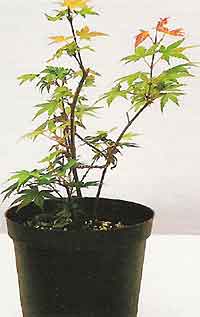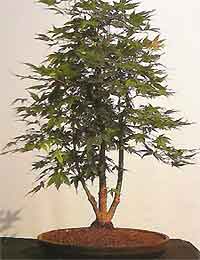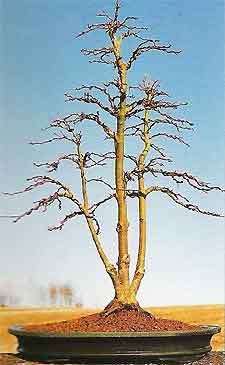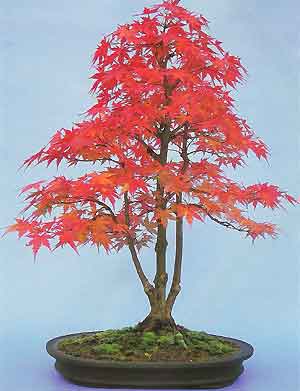Bonsai Trees
Case Histories
Japanese Mountain Maple - (acer palmatum)
Maple Bonsai Style: Triple Trunk

The following two trees (see next maple history) were both air layered from the maple detailed in the previous history. They illustrate how by selective air layering, good bonsai can been created in a relatively short space of time and how a choice of styles can be achieved according to the point where the air layer is taken.
As the maples share the same 'mother' plant, they have identical leaf size, shape and growth pattern, although the styles are completely different. They have, however, both received the same training techniques and care.
Maple Bonsai History: Training

Keen to propagate a multi-trunked maple, an ideal branch that divided into three was chosen. I ring barked directly underneath where the branches joined and completed the air layering technique. When adequate roots had emerged five weeks later, the tree was planted in a flower pot and placed out of the strong sun, in a sheltered area of the garden. I carefully tied the trunks together so that they would grow more closely and this was the only training carried out that year.
The triple trunk maple was planted in a larger flower pot in the spring . A good buttress was developing and the surface roots were already excellent, as is so often the case with air layered trees. Now that the tree was strong I began feeding heavily, to encourage vigourous growth and help the trunks thicken. I allowed the main trunk to grow without pruning for a further year, and lightly trimmed the other trunks, to ensure that they attained different girths.

In the autumn the tree was very overgrown and three thick trunks were now apparent. The best viewing angle was clear, with the smallest trunk being on the left-hand side and angled slight forward and the middle sized trunk more towards the back.
This ensured good depth and perspective, rather than having the three trunks all in a line. Unnecessary branches were removed and the trunks were reduced in height, using suitable side branches to become the new leaders.
This improved the taper and I wired several of the main branches in a slightly downwards direction, curving them up towards the end of the branches. In spring the maple was root pruned and planted into an oval bonsai pot.
Training for the next five years consisted of much pinching and pruning as the shoots extended. Every spring the tree was repotted and each time care was taken to expose more surface roots.
Several roots were repositioned and secured in place using wire pegs shaped like staples. By now the tree was becoming quite imposing and had started to outgrow its pot.

A larger, shallower dark grey oval pot was selected and used. The tree was planted slightly to the right of the pot, to counterbalance the movement of the left-hand trunk and I spent several hours thoroughly structuring and wiring every single branch. Some branches were now removed to provide a more open appearance when in leaf and allow individual branches to be seen.
The maple looked far more impressive and elegant, with the overall appearance now greatly improved. Older looking bark has started to form on the lower trunks, helping them achieve an appearance of maturity.
 The following two trees (see next maple history) were both air layered from the maple detailed in the previous history. They illustrate how by selective air layering, good bonsai can been created in a relatively short space of time and how a choice of styles can be achieved according to the point where the air layer is taken.
The following two trees (see next maple history) were both air layered from the maple detailed in the previous history. They illustrate how by selective air layering, good bonsai can been created in a relatively short space of time and how a choice of styles can be achieved according to the point where the air layer is taken. Keen to propagate a multi-trunked maple, an ideal branch that divided into three was chosen. I ring barked directly underneath where the branches joined and completed the air layering technique. When adequate roots had emerged five weeks later, the tree was planted in a flower pot and placed out of the strong sun, in a sheltered area of the garden. I carefully tied the trunks together so that they would grow more closely and this was the only training carried out that year.
Keen to propagate a multi-trunked maple, an ideal branch that divided into three was chosen. I ring barked directly underneath where the branches joined and completed the air layering technique. When adequate roots had emerged five weeks later, the tree was planted in a flower pot and placed out of the strong sun, in a sheltered area of the garden. I carefully tied the trunks together so that they would grow more closely and this was the only training carried out that year. In the autumn the tree was very overgrown and three thick trunks were now apparent. The best viewing angle was clear, with the smallest trunk being on the left-hand side and angled slight forward and the middle sized trunk more towards the back.
In the autumn the tree was very overgrown and three thick trunks were now apparent. The best viewing angle was clear, with the smallest trunk being on the left-hand side and angled slight forward and the middle sized trunk more towards the back. A larger, shallower dark grey oval pot was selected and used. The tree was planted slightly to the right of the pot, to counterbalance the movement of the left-hand trunk and I spent several hours thoroughly structuring and wiring every single branch. Some branches were now removed to provide a more open appearance when in leaf and allow individual branches to be seen.
A larger, shallower dark grey oval pot was selected and used. The tree was planted slightly to the right of the pot, to counterbalance the movement of the left-hand trunk and I spent several hours thoroughly structuring and wiring every single branch. Some branches were now removed to provide a more open appearance when in leaf and allow individual branches to be seen.